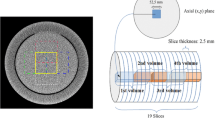Abstract
The aim of this study is to determine the dependence of single photon emission computed tomography (SPECT) spatial resolution on the content of images for iterative reconstruction with distance dependent resolution (DDR) correction. An experiment was performed using a perturbation technique to measure change in resolution of line sources in simple and complex images with iterative reconstruction with increasing iteration. Projections of the line sources were reconstructed alone and again after the addition of projections of a uniform flood or a complex phantom. An alternative experiment used images of a realistic brain phantom and evaluated an effective spatial resolution by matching the images to the digital version of the phantom convolved with 3D Gaussian kernels. The experiments were performed using ordered subset expectation maximisation iterative reconstruction with and without the use of DDR correction. The results show a significant difference in reconstructed resolution between images of line sources depending on the content of the added image. The full width at half maximum of images of a line source reconstructed using DDR correction increased by 20–30 % when the added image was complex. Without DDR this difference was much smaller and disappeared with increasing iteration. Reported SPECT resolution should be taken as indicative only with regard to clinical imaging if the measurement is made using a point or line source alone and an iterative reconstruction algorithm is used.





Similar content being viewed by others
References
Stamos JA, Rogers WL, Clinthorne NH, Koral KF (1988) Object dependent performance comparison of two iterative reconstruction algorithms. IEEE Trans Nucl Sci 35:611–614
Yokoi T, Shinohara H, Onishi H (2002) Performance evaluation of OSEM reconstruction algorithm incorporating three-dimensional distance-dependent resolution compensation for brain SPECT: a simulation study. Ann Nucl Med 16:11–18
Daou D, Pointurier I, Coaguila C, Vilain D, Benada A, Lebtahi R, Fourme T, Slama M, Le Guludec D (2003) Performance of OSEM and depth-dependent resolution recovery algorithms for the evaluation of global left ventricular function in 201Tl gated myocardial perfusion SPECT. J Nucl Med 44:155–162
Williams R, Lichtenstein M, and Westcott J (2005) 3d resolution recovery iterative SPECT reconstruction and its impact on image quality and collimator choice. In: Australian & New Zealand Society of Nuclear Medicine 35th Annual Scientific Meeting
Venero C, Heller G, Bateman T, McGhie A, Ahlberg A, Katten D, Courter S, Golub R, Case J, Cullom S (2009) A multicenter evaluation of a new post-processing method with depth dependent collimator resolution applied to full-time and half-time acquisitions without and with simultaneously acquired attenuation correction. J Nucl Cardiol 16:120–126
Cantinho G, Pena H, Cerqueira D, Clemente J, and Godinho F (2010) Half dose MIBG cardiac SPECT clinical evaluation of resolution recovery methods, World Molecular Imaging Congress
Dickson J, Tossici Bolt L, Sera T, Erlandsson K, Varrone A, Tatsch K, Hutton B (2010) The impact of reconstruction method on the quantification of DaTSCAN images. Eur J Nucl Med Mol Imaging 37:23–25
Knoll P, Kotalova D, Köchle G, Kuzelka I, Minear G, Mirzaei S, Samal M, Zadrazil L, Bergmann H (2011) Comparison of advanced iterative reconstruction methods for spect/ct. Z Med Phys 22:58–69
O’Mahoney E, Murray I (2013) Evaluation of a matched filter resolution recovery reconstruction algorithm for SPECT-CT imaging. Nucl Med Commun 34(3):240–248
Frey E, Tsui B (2006) Collimator-detector response compensation in SPECT. In: Zaidi H (ed) Quantitative analysis in nuclear medicine imaging. Springer, Berlin, pp 141–166
Erlandsson K, Kacperski K, van Gramberg D, Hutton BF (2009) Performance evaluation of D-SPECT: a novel SPECT system for nuclear cardiology. Phys Med Biol 54:2635
El Fakhri G, Surti S, Trott CM, Scheuermann J, Karp JS (2011) Improvement in lesion detection with whole-body oncologic time-of-flight PET. J Nucl Med 52(3):347–353
Hoffman EJ, Cutler PD, Digby WM, Mazziotta JC (1990) 3-D phantom to simulate cerebral blood flow and metabolic images for PET. EEE Trans Nucl Sci 37:616–620
Hudson H, Larkin R (1994) Accelerated image reconstruction using ordered subsets of projection data. IEEE Trans Med Imaging 13:601–609
Barnden L, Dickson J, Hutton B (2006) Detection and validation of the body edge in low count emission tomography images. Comput Methods Prog Biomed 84:153–161
Barnden L, Hatton R, Behin Ain S, Hutton B, Goble E (2004) Optimization of brain SPET and portability of normal databases. Eur J Nucl Med Mol Imaging 31:378–387
Author information
Authors and Affiliations
Corresponding author
Rights and permissions
About this article
Cite this article
Badger, D., Barnden, L. Spatial resolution is dependent on image content for SPECT with iterative reconstruction incorporating distance dependent resolution (DDR) correction. Australas Phys Eng Sci Med 37, 551–557 (2014). https://doi.org/10.1007/s13246-014-0287-4
Received:
Accepted:
Published:
Issue Date:
DOI: https://doi.org/10.1007/s13246-014-0287-4




